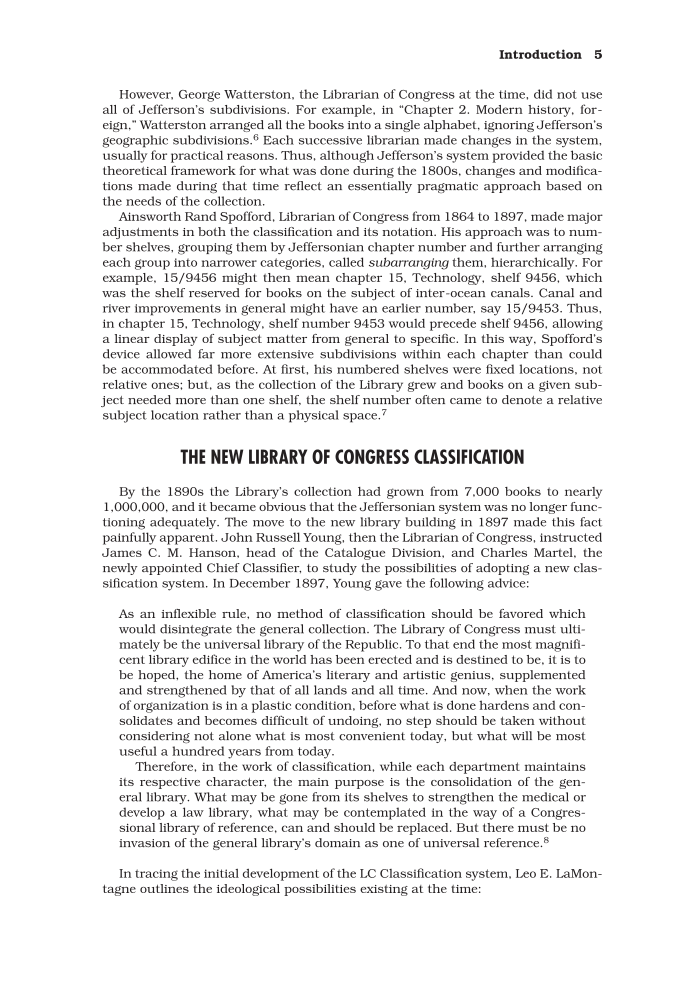Introduction 5 However, George Watterston, the Librarian of Congress at the time, did not use all of Jefferson’s subdivisions. For example, in “Chapter 2. Modern history, for- eign,” Watterston arranged all the books into a single alphabet, ignoring Jefferson’s geographic subdivisions.6 Each successive librarian made changes in the system, usually for practical reasons. Thus, although Jefferson’s system provided the basic theoretical framework for what was done during the 1800s, changes and modifica- tions made during that time reflect an essentially pragmatic approach based on the needs of the collection. Ainsworth Rand Spofford, Librarian of Congress from 1864 to 1897, made major adjustments in both the classification and its notation. His approach was to num- ber shelves, grouping them by Jeffersonian chapter number and further arranging each group into narrower categories, called subarranging them, hierarchically. For example, 15/9456 might then mean chapter 15, Technology, shelf 9456, which was the shelf reserved for books on the subject of inter-ocean canals. Canal and river improvements in general might have an earlier number, say 15/9453. Thus, in chapter 15, Technology, shelf number 9453 would precede shelf 9456, allowing a linear display of subject matter from general to specific. In this way, Spofford’s device allowed far more extensive subdivisions within each chapter than could be accommodated before. At first, his numbered shelves were fixed locations, not relative ones but, as the collection of the Library grew and books on a given sub- ject needed more than one shelf, the shelf number often came to denote a relative subject location rather than a physical space.7 THE NEW LIBRARY OF CONGRESS CLASSIFICATION By the 1890s the Library’s collection had grown from 7,000 books to nearly 1,000,000, and it became obvious that the Jeffersonian system was no longer func- tioning adequately. The move to the new library building in 1897 made this fact painfully apparent. John Russell Young, then the Librarian of Congress, instructed James C. M. Hanson, head of the Catalogue Division, and Charles Martel, the newly appointed Chief Classifier, to study the possibilities of adopting a new clas- sification system. In December 1897, Young gave the following advice: As an inflexible rule, no method of classification should be favored which would disintegrate the general collection. The Library of Congress must ulti- mately be the universal library of the Republic. To that end the most magnifi- cent library edifice in the world has been erected and is destined to be, it is to be hoped, the home of America’s literary and artistic genius, supplemented and strengthened by that of all lands and all time. And now, when the work of organization is in a plastic condition, before what is done hardens and con- solidates and becomes difficult of undoing, no step should be taken without considering not alone what is most convenient today, but what will be most useful a hundred years from today. Therefore, in the work of classification, while each department maintains its respective character, the main purpose is the consolidation of the gen- eral library. What may be gone from its shelves to strengthen the medical or develop a law library, what may be contemplated in the way of a Congres- sional library of reference, can and should be replaced. But there must be no invasion of the general library’s domain as one of universal reference.8 In tracing the initial development of the LC Classification system, Leo E. LaMon- tagne outlines the ideological possibilities existing at the time:
Document Details My Account Print multiple pages
Print
You have printed 0 times in the last 24 hours.
Your print count will reset on at .
You may print 0 more time(s) before then.
You may print a maximum of 0 pages at a time.






































































































































































































































































































































































































